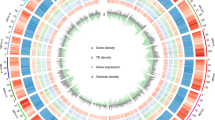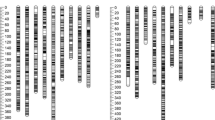Abstract
We present SSR-based genetic maps from a cross between Miscanthus sacchariflorus Robustus and M. sinensis, the progenitors of the promising cellulosic biofuel feedstock Miscanthus × giganteus. cDNA-derived SSR markers were mapped by the two-way pseudo-testcross model due to the high heterozygosity of each parental species. A total of 261 loci were mapped in M. sacchariflorus, spanning 40 linkage groups and 1,998.8 cM, covering an estimated 72.7% of the genome. For M. sinensis, a total of 303 loci were mapped, forming 23 linkage groups and 2,238.3 cM, covering 84.9% of the genome. The use of cDNA-derived SSR loci permitted alignment of the Miscanthus linkage groups to the sorghum chromosomes, revealing a whole genome duplication affecting the Miscanthus lineage after the divergence of subtribes Sorghinae and Saccharinae, as well as traces of the pan-cereal whole genome duplication. While the present maps provide for many early research needs in this emerging crop, additional markers are also needed to improve map density and to further characterize the structural changes of the Miscanthus genome since its divergence from sorghum and Saccharum.





Similar content being viewed by others
References
Adati S, Shiotani I (1962) The cytotaxonomy of the genus Miscanthus and its phylogenic status. Bull Fac Agric Mie Univ 25:1–14
Akkaya MS, Bhagwat AA, Cregan PB (1992) Length polymorphisms of simple sequence repeat DNA in soybean. Genetics 132:1131–1139
Al-Janabi SM, Honeycutt RJ, McClelland M, Sobral BWS (1993) A genetic linkage map of Saccharum spontaneum L. ‘SES 208′. Genetics 134:1249–1260
Atienza SG, Satovic Z, Peterson KK, Dolstra O (2002) Preliminary genetic linkage map of Miscanthus sinensis with RAPD markers. Theor Appl Genet 105:946–952
Bethel CM, Sciara EB, Estill JC, Bowers JE, Hanna W, Paterson AH (2006) A framework linkage map of bermudagrass (Cynodon dactylon × transvaalensis) based on single-dose restriction fragments. Theor Appl Genet 112:727–737
Botstein D, White RL, Skolnick M, Davis RW (1980) Construction of a genetic linkage map in man using restriction fragment length polymorphisms. Am J Hum Genet 32:314–331
Bowers JE, Abbey C, Anderson S et al (2003) A high-density genetic recombination map of sequence-tagged sites for Sorghum, as a framework for comparative structural and evolutionary genomics of tropical grains and grasses. Genetics 165:367–386
Cai Q, Aitken KS, Fan YH, Piperidis G, Jacson P, McIntyre CL (2005) A preliminary assessment of the genetic relationship between Erianthus rockii and the “Saccharum complex” using microsatellite (SSR) and AFLP markers. Plant Sci 169:946–984
Carr DE, Dudash MR (2003) Recent approaches into the genetic basis of inbreeding depression in plants. Phil Trans R Soc Lond B 358:1071–1084
Chakravarti A, Lasher LK, Reefer JE (1991) A maximum likelihood method for estimating genome length using genetic linkage data. Genetics 128:175–182
Chiang Y-C, Schaal BA, Chou C-H, Huang S, Chiang T-Y (2003) Contrasting selection modes at the Adh1 locus in outcrossing Miscanthus sinensis vs. inbreeding Miscanthus condensatus (Poaceae). Am J Bot 90:561–570
Chou C-H, Chiang Y-C, Chiang T-Y (1999) Within- and between-individual length hetero-geneity of the rDNA-IGS in Miscanthus sinensis var. glaber (Poaceae): phylogenetic analyses. Genome 42:1088–1093
Chou C-H, Chiang Y-C, Chiang T-Y (2000) Genetic variability and phylogeography of Miscanthus sinensis var. condensatus, an apomictic grass, based on RAPD fingerprints. Can J Bot 78:1262–1268
Clifton-Brown JC, Lewandowski I, Andersson B, Basch G, Christian DG, Kjeldsen JB, Jorgensen U, Mortensen JV, Riche AB, Schwarz K-U, Tayebi K, Teixeira F (2001) Performance of 15 Miscanthus genotypes at five sites in Europe. Agron J 93:1013–1019
Daniels J, Smith P, Panton N, Williams CA (1975) The origin of the genus Saccharum. Sugarcane Breed Newsl 36:24–39
Edgar RC (2004) MUSCLE: a multiple sequence alignment method with reduced time and space complexity. BMC Bioinformatics 5:113
Fishman L, Kelly AJ, Morgan E, Willis JH (2001) A genetic map in the Mimulus guttatus species complex reveals transmission ratio distortion due to heterospecific interactions. Genetics 159:1701–1716
Grattapaglia D, Sederoff R (1994) Genetic linkage maps of Eucalyptus grandis and Eucalyptus urophylla using a pseudo-testcross: mapping strategy and RAPD markers. Genetics 137:1121–1137
Greef JM, Deuter M, Jung C, Schondelmaier J (1997) Genetic diversity of European Miscanthus species revealed by AFLP fingerprinting. Genet Resour Crop Evol 44:185–195
Grivet L, D’Hont A, Roques D, Feldmann P, Lanaud C, Glaszmann JC (1996) RFLP mapping in cultivated sugarcane (Saccharum spp.): genome organization in a highly polyploid and aneuploid interspecific hybrid. Genetics 142:987–1000
Heaton EA, Dohleman FG, Long SP (2008) Meeting US biofuel goals with less land: the potential of Miscanthus. Global Change Biol 14:1–15
Hirayoshi I, Nishikawa K, Kubono M, Murase T (1957) Cyto-genetical studies on forage plants (VI) on the chromosome number of Ogi (Miscanthus sacchariflorus). Res Bull Fac Agric Gifu Univ 8:8–13
Hodkinson TR, Renvoize S (2001) Nomenclature of Miscanthus × giganteus (Poaceae). Kew Bull 56:759–760
Hodkinson TR, Chase MW, Lledo MD, Salamin N, Renvoize SA (2002a) Phylogenetics of Miscanthus, Saccharum and related genera (Saccharinae, Andropogoneae, Poaceae) based on DNA sequences from ITS nuclear ribosomal DNA and plastid trnL intron and trnL-F intergenic spacers. J Plant Res 115:381–392
Hodkinson TR, Chase MW, Renvoize SA (2002b) Characterization of genetic resource collection for Miscanthus (Saccharinae, Andropogoneae, Poaceae) using AFLP and ISSR PCR. Ann Bot 89:627–636
Hodkinson TR, Chase MW, Takahashi C, Leitch IJ, Bennett MD, Renvoize SA (2002c) The use of DNA sequencing (ITS and trnL-F) AFLP and fluorescent in situ hybridization to study allopolyploid Miscanthus (Poaceae). Am J Bot 89(2):279–286
Hung K-H, Chiang T-Y, Chiu C-T, Hsu T-W, Ho C-W (2009) Isolation and characterization of microsatellite loci from a potential biofuel plant Miscanthus sinensis (Poaceae). Conserv Genet 10:1377–1380
Inoue M, Gao Z, Hirata M, Fujimori M, Cai H (2004) Construction of a high-density linkage map of Italian ryegrass (Lolium multiflorum Lam.) using restriction fragment length polymorphism, amplified fragment length polymorphism, and telomeric repeat associated sequence markers. Genome 47:57–65
Iwata H, Kamijo T, Tsumura Y (2005) Genetic structure of Miscanthus sinensis ssp. condensatus (Poaceae) on Miyake Island: implications for revegetation of volcanically devastated sites. Ecol Res 20:233–238
Jordan SA, Humphries P (1994) Single nucleotide polymorphism in exon 2 of the BCP gene on 7q31–q35. Hum Mol Genet 3:1915
Kapustin Y, Souvorov A, Tatusova T, Lipman D (2008) Splign: algorithms for computing spliced alignments with identification of paralogs. Biol Direct 3:20
Kim C, Tang H, Paterson AH (2009) Duplication and divergence of grass genomes: integrating the Chloridoids. Tropical Plant Biol 2:51–62
Krzywinski M, Schein J, Birol I, Connors J, Gascoyne R, Horsman D, Jones SJ, Marra MA (2009) Circos: an information aesthetic for comparative genomics. Genome Res 19:1639–1645
Lafferty J, Lelley T (1994) Cytogenetic studies of different Miscanthus species with potential for agricultural use. Plant Breed 113:246–249
Lander ES, Green P, Abrahamson J, Barlow A, Daly MJ, Lincoln SE, Newburg L (1987) MAPMAKER: an interactive computer package for constructing primary genetic linkage maps of experimental and natural populations. Genomics 1:174–181
Linde-Laursen I (1993) Cytogenetic analysis of Miscanthus ‘Giganteus’, an interspecific hybrid. Hereditas 119:297–300
Ming R, Liu S-C, Lin T-R, da Silva J, Wilson W, Braga D, van Deynze A, Wenslaff TF, Wu KK, Moore PH, Burnquist W, Sorrells ME, Irvine JE, Paterson AH (1998) Detailed alignment of Saccharum and sorghum chromosomes: comparative organization of closely related diploid and polyploid genomes. Genetics 150:1663–1682
Missaoui AM, Paterson AH, Bouton JH (2005) Investigation of genomic organization in switchgrass (Panicum virgatum L.) using DNA markers. Theor Appl Genet 110:1372–1383
Okada M, Lanzatella C, Saha MC, Bouton J, Wu R, Tobias CM (2010) Complete switchgrass genetic maps reveal subgenome collinearity preferential pairing and multilocus interactions. Genetics 185:745–760
Paterson AH, Bowers JE, Chapman BA (2004) Ancient polyploidization predating divergence of the cereals, and its consequences for comparative genomics. Proc Natl Acad Sci USA 101:9903–9908
Paterson AH, Bowers JE, Bruggmann R et al (2009) The Sorghum bicolor genome and the diversification of grasses. Nature 457:551–556
Porceddu A, Albertini E, Barcaccia G, Falistocco E, Falcinelli M (2002) Linkage mapping in apomictic and sexual Kentucky bluegrass (Poa pratensis L.) genotypes using a two way pseudo-testcross strategy based on AFLP and SAMPL markers. Theor Appl Genet 104:273–280
Rayburn AL, Crawford J, Rayburn CM, Juvik JA (2009) Genome size of three Miscanthus species. Plant Mol Biol Rep 27:184–188
Rozen S, Skaletsky HJ (2000) Primer3 on the WWW for general users and for biologist programmers. Meth Mol Biol 132:365–386
Stein J, Pessino SC, Martinez EJ, Rodriguez MP, Siena LA, Quarin CL, Pablo J, Ortiz A (2007) A genetic map of tetraploid Paspalum nonatum Flugge (bahiagrass) based on single-dose molecular markers. Mol Breed 20:153–166
Venkateswarlu M, Raje Urs S, Surendra Nath B, Shashidhar HE, Maheswaran M, Veeraiah TM, Sabitha MG (2006) A first genetic linkage map of mulberry (Morus spp.) using RAPD, ISSR, and SSR markers and pseudotestcross mapping strategy. Tree Genet Genomes 3:15–24
Von Wuhlisch G, Deuter M, Muhs H-J (1994) Identifizierung verschiedener Miscanthus-Sorten mittels Isoenzymen. Agron Crop Sci 172:247–254
Voorrips RE (2002) MapChart: software for the graphical presentation of linkage maps and QTLs. J Hered 93:77–78
Wang X, Shi X, Hao B, Ge S, Luo J (2005) Duplication and DNA segmental loss in the rice genome: implications for diploidization. New Phytol 165:937–946
Xue D, Feng S, Zhao H, Jiang H, Shen B, Shi N, Lu J, Liu J, Wang H (2010) The linkage maps of Dendrobium species based on RAPD and SRAP markers. J Genet Genomics 37:197–204
Yin T, Huang M, Wang M, Zhu L-H, Zeng Z-B, Wu R (2001) Preliminary interspecific genetic maps of the Populus genomes constructed from RAPD markers. Genome 44:602–609
Acknowledgments
This work was supported by the US Department of Energy-US Department of Agriculture Plant Feedstock Program (project grant number: 112786), the Consortium for Plant Biotechnology Research (CPBR), and Mendel Biotechnology.
Author information
Authors and Affiliations
Corresponding author
Additional information
Communicated by E. Guiderdoni.
Electronic supplementary material
Below is the link to the electronic supplementary material.
Rights and permissions
About this article
Cite this article
Kim, C., Zhang, D., Auckland, S.A. et al. SSR-based genetic maps of Miscanthus sinensis and M. sacchariflorus, and their comparison to sorghum. Theor Appl Genet 124, 1325–1338 (2012). https://doi.org/10.1007/s00122-012-1790-1
Received:
Accepted:
Published:
Issue Date:
DOI: https://doi.org/10.1007/s00122-012-1790-1




